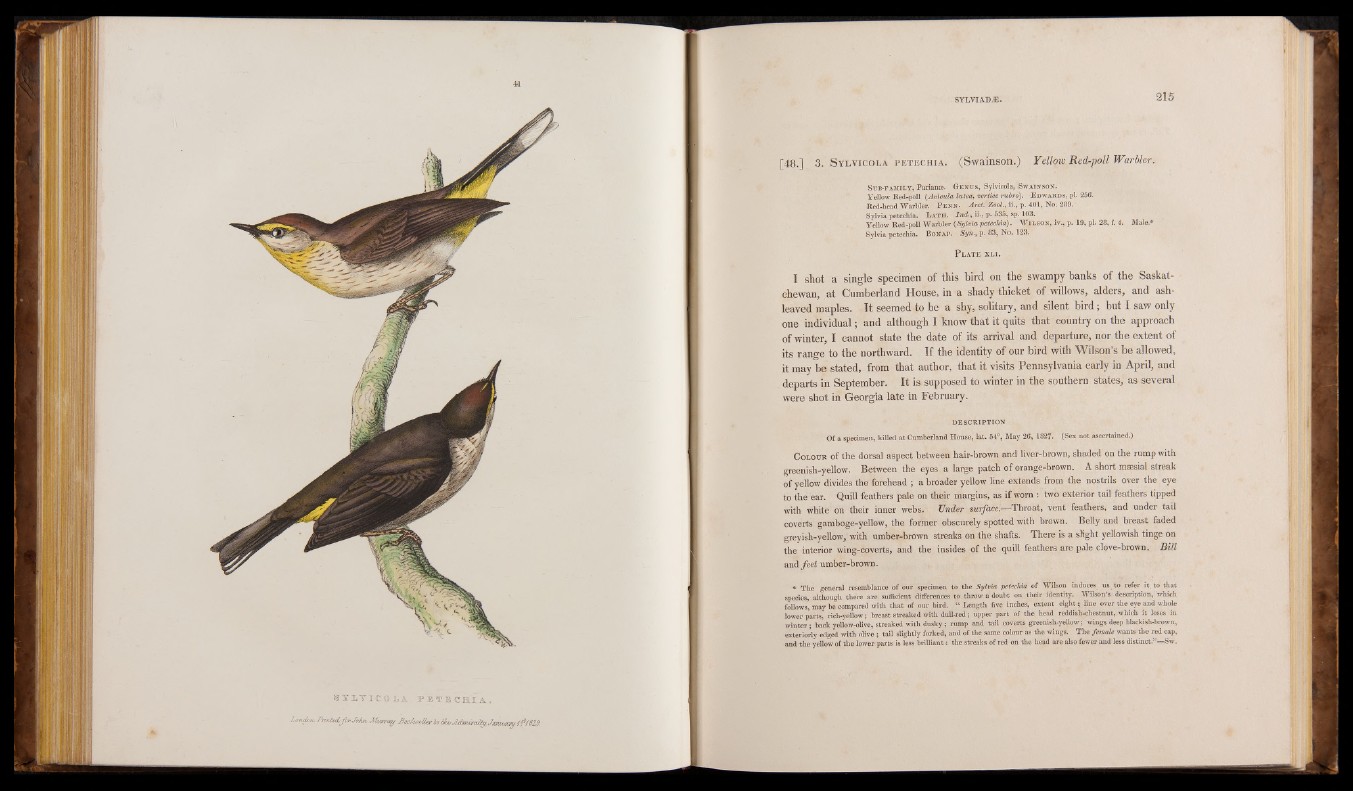
[48.] 3. S y l v i c o l a p e t e c h i a . (Swainson.) Yellow Red-poll Warbler.
Sub-fa m il y , Parian®. Ge n u s , Sylvicola, Sw ainson ;
Yellow Red-poll (Avicula lutea, vertice rubro). E dwards, pi. 256.
Red-head Warbler. P e n n . Arct. Zool., ii., p. 401, No. 289.
Sylvia petechia. L a t h . Ind., ii., p. 535, sp. 103.
Yellow Red-poll Warbler (Sylvia petechia). W il so n , iv., p. 19, pi. 28, f. 4. Male.*
Sylvia petechia. B o nap. Syn., p. 83, No. 123.
P late x l i.
I shot a single specimen of this bird on the swampy banks of the Saskat-
chewan, at Cumberland House, in a shady thicket of willows, alders, and ashleaved
maples. It seemed to he a shy, solitary, and silent bird; but I saw only
one individual; and although I know that it quits that country on the approach
of winter, I cannot state the date of its arrival and departure, nor the extent of
its range to the northward. If the identity of our bird with Wilson’s be allowed,
it may be stated, from that author, that it visits Pennsylvania early in April, and
departs in September. It is supposed to winter in the southern states, as several
were shot in Georgia late in February.
DESCRIPTION
Of a specimen, killed at Cumberland House, lat. 54°, May 26, 1827. (Sex not ascertained.)
C olour of the dorsal aspect between hair-brown and liver-brown, shaded on the rump with
greenish-yellow. Between the eyes a large patch of orange-brown. A short maesial streak
of yellow divides the forehead ; a broader yellow line extends from the nostrils over the eye
to the ear. Quill feathers pale on their margins, as if worn : two exterior tail feathers tipped
with white on their inner webs. Under surface.—Throat, vent feathers, and under tail
coverts gamboge-yellow, the former obscurely spotted with brown. Belly and breast faded
greyish-yellow, with umber-brown streaks on the shafts. There is a slight yellowish tinge ort
the interior wing-coverts, and the insides of the quill feathers are pale clove-brown. Bill
and feet umber-brown.
* The general resemblance of our specimen to the Sylvia petechia of Wilson induces us to refer it. to that
species, although there are sufficient differences to throw a doubt on their identity. Wilsbn’S description, which
follows, may be compared with that of our bird. “ Length five inches, extent eight; line over the eye and whole
lower parts, rich-yellow; breast streaked with dull-red; upper part of the head reddish-chestnut, which it loses in
winter ; back yellow-olive, streaked with dusky; rump and tail coverts greenish-yellow; wings deep blackish-brown,
exteriorly edged with olive ; tail slightly forked, and of the same colour as the wings. The female wants the red cap,
aud the yellow of the lower parts is less brilliant: the streaks of red on the head are also fewer and less distinct.”—Sw.